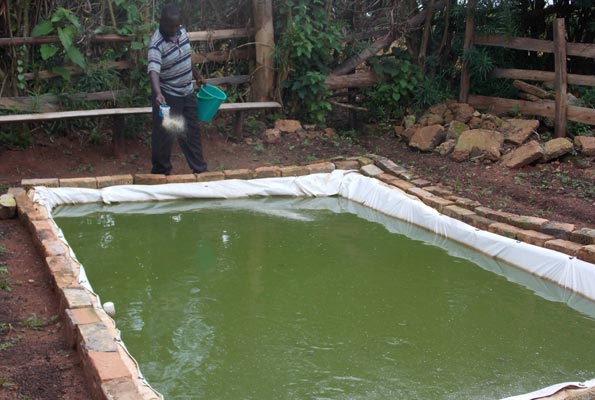
Lubega Wavamunno, who lives on a hill in Nkalwe Village, Kingo Sub-county in Lwengo District in Uganda, is determined to carries out fish farming. And he does this out in his backyard. So far, there is one fish pond but he is planning on a few more after discovering that it can be done using rainwater harvested from the roof of his house.
“I began rearing fish last year in a 120-litre water tank,” says Lubega, also a coffee and banana farmer. “I reared nine catfish to maturity in just eight months and we ate them at home. I realised that fish farming does not have to be in the wetlands. It can be done at home with rainwater.”
At the start
About four months ago, he put 450 fingerlings of catfish in a 12 by 10 feet pond and three feet deep. “I visited experienced fish farmers in Masaka sub-region like Paul Ssekyewa of Ssenya Fish Farms, from where I got guidance. I also read a few books on the subject,” he says.
It took me and a worker just two days to dig the pit, which I fitted with tarpaulin to prevent the water from seeping into the ground. When it rained it got filled. But before I introduced the fingerlings into the water, I put half a sack of cow dung into the pond to enable a right environment for the organisms, which fish feed on to thrive.”
Lubega paid 10 Kenya Shillings for each fingerling. He hopes to sell each mature catfish after eight months at not less than 300 Kenya Shillings.
“They can feed on livestock feeds. I thought I would get chicken feed for them but it was rather expensive. I chose to buy mukene (silver fish), which I crushed into powder, mixed it with soya flour and then maize bran. For the last four months, I have been throwing 50 grammes of the homemade feed into the pond every day. I have discovered that the fish are growing pretty fast. I am about to increase the feeds ration to a kilogramme per day.”
The feeds issue
This means that he will need about 100 kilos in the next three months to when the fish reach maturity. “A fish farmer does not worry as much as a poultry keeper about feeds,” he says adding “For fish to grow well, they do not need to be fed on any food bought from shops and farmers need not to worry about feeding expenses.
“They eat leftover vegetable crops, algae which easily form in the water when small amounts of cow dung are thrown into the pond. They also eat mosquitoes and other insects that settle on the water. Soon, I will install a solar-powered lamp fixed on a pole at night so that it is reflected by the water. The idea is that the lamp’s reflection will attract insects to the water for the fish to eat.
Keep it fresh
Keep in mind that fish live in lakes and rivers where they are not given food by human beings. They have the capacity to survive on insects, worms, and vegetable matter.”
There is an outlet pipe at one side of the pond so that when it rains, fresh water goes into the pond while an equal amount of water flows out.
“Fish need fresh water regularly,” Lubega explained. “When it rains, fresh water gets into the pond quite regularly. But when it is dry, I will use about six 20-litre jerrycans of fresh water every now and again—about four times a month.”
The farm is now connected to the public piped-water system and there is a water tap right in his compound.
The water flowing out of the fish pond is directed into the vegetable garden and he has a lot of praise for the vigour with which they are growing.




